Brother S-6200A Instruction Manual

S-6200A |
INSTRUCTION MANUAL |
|
Please read this manual before using the machine.
Please keep this manual within easy reach for quick reference.
SINGLE NEEDLE STRAIGHT LOCK STITCHER
WITH THREAD TRIMMER
Thank you very much for buying a BROTHER sewing machine. Before using your new machine, please read the safety instructions and the explanations given in the instruction manual.
With industrial sewing machines, it is normal to carry out work while positioned directly in front of moving parts such as the needle and thread take-up, and consequently there is always a danger of injury that can be caused by these parts. Follow the instructions from training personnel and instructors regarding safe and correct operation before operating the machine so that you will know how to use it correctly.
S-6200A

SAFETY INSTRUCTIONS
[1] Safety indications and their meanings
This instruction manual and the indications and symbols that are used on the machine itself are provided in order to ensure safe operation of this machine and to prevent accidents and injury to yourself or other people.
The meanings of these indications and symbols are given below.
Indications
DANGER |
The instructions which follow this term indicate situations where failure to follow the |
instructions will result in death or serious injury. |
|
|
|
CAUTION |
The instructions which follow this term indicate situations where failure to follow the |
instructions could cause injury when using the machine or physical damage to |
|
|
equipment and surroundings. |
Symbols |
|
 · · · · ·
· · · · ·
 · · · · ·
· · · · ·
 · · · · ·
· · · · ·
This symbol (  ) indicates something that you should be careful of. The picture inside the triangle indicates the nature of the caution that must be taken.
) indicates something that you should be careful of. The picture inside the triangle indicates the nature of the caution that must be taken.
(For example, the symbol at left means “beware of injury”.)
This symbol (  ) indicates something that you must not do.
) indicates something that you must not do.
This symbol (  ) indicates something that you must do. The picture inside the circle indicates the nature of the thing that must be done.
) indicates something that you must do. The picture inside the circle indicates the nature of the thing that must be done.
(For example, the symbol at left means “you must make the ground connection”.)
S-6200A |
i |

[2] Notes on safety
 DANGER
DANGER
Wait at least 5 minutes after turning off the power switch and disconnecting the power cord from the wall outlet before opening the cover of the control box. Touching areas where high voltages are present can result in severe injury.
 CAUTION
CAUTION
Environmental requirements
Use the sewing machine in an area which is free |
The ambient temperature should be within the |
|
from sources of strong electrical noise such as |
range of 5°C to 35°C during use. |
|
electrical line noise or static electric noise. |
Temperatures which are lower or higher than this |
|
Sources of strong electrical noise may cause |
may cause problems with correct operation. |
|
problems with correct operation. |
The relative humidity should be within the range of |
|
Any fluctuations in the power supply voltage |
||
45% to 85% during use, and no dew formation |
||
should be within ±10% of the rated voltage for the |
should occur in any devices. |
|
machine. |
Excessively dry or humid environments and dew |
|
Voltage fluctuations which are greater than this |
formation may cause problems with correct |
|
may cause problems with correct operation. |
operation. |
|
The power supply capacity should be greater than |
In the event of an electrical storm, turn off the power |
|
the requirements for the sewing machine's power |
and disconnect the power cord from the wall outlet. |
|
consumption. |
Lightning may cause problems with correct |
|
Insufficient power supply capacity may cause |
operation. |
|
problems with correct operation. |
|
Installation
Machine installation should only be carried out by |
If using a work table which has casters, the casters |
|||||
a qualified technician. |
|
|
should be secured in such a way so that they |
|||
Contact your Brother dealer or a qualified |
cannot move. |
|||||
Secure the table so that it will not move when tilting |
||||||
electrician for any electrical work that may need to |
||||||
be done. |
|
|
|
|
back the machine head. If the table moves, it may |
|
The sewing machine weighs approximately 38 kg |
crush your feet or cause other injuries. |
|||||
|
||||||
(84lb). The installation should be carried out by |
Use both hands to hold the machine head when |
|||||
two or more people. |
|
|
tilting it back or returning it to its original position. If |
|||
Do not connect the power cord until installation is |
only one hand is used, the weight of the machine |
|||||
head may cause your hand to slip, and your hand |
||||||
complete. The machine may operate if the treadle |
||||||
may get caught. |
||||||
is depressed by mistake, which could result in |
||||||
Be sure to wear protective goggles and gloves |
||||||
injury. |
|
|
|
|
||
Turn off |
the |
power |
switch before inserting |
or |
when handling the lubricating oil and grease, so that |
|
they do not get into your eyes or onto your skin, |
||||||
removing |
the |
plug, |
otherwise damage to |
the |
||
otherwise inflammation can result. |
||||||
control box could result. |
|
|||||
|
Furthermore, do not drink the oil or eat the grease |
|||||
|
|
|
|
|
||
Be sure to connect the ground. If the ground |
under any circumstances, as they can cause |
|||||
connection is not secure, you run a high risk of |
vomiting and diarrhea. |
|||||
receiving a serious electric shock, and problems |
Keep the oil out of the reach of children. |
|||||
with correct operation may also occur.
When securing the cords, do not bend the cords excessively or fasten them too hard with staples, otherwise there is the danger that fire or electric shocks could occur.
ii |
S-6200A |

 CAUTION
CAUTION
Sewing
This sewing machine should only be used by |
Attach all safety devices before using the sewing |
||
operators who have received the necessary training |
machine. If the machine is used without these |
||
in safe use beforehand. |
devices attached, injury may result. |
||
The sewing machine should not be used for any |
Do not touch any of the moving parts or press any |
||
applications other than sewing. |
objects against the machine while sewing, as this |
||
Be sure to wear protective goggles when using the |
may result in personal injury or damage to the |
||
machine. |
|||
machine. |
|||
Secure the table so that it will not move when tilting |
|||
If goggles are not worn, there is the danger that if a |
|||
needle breaks, parts of the broken needle may enter |
back the machine head. If the table moves, it may |
||
your eyes and injury may result. |
crush your feet or cause other injuries. |
||
Turn off the power switch at the following times. |
Use both hands to hold the machine head when |
||
The machine may operate if the treadle is |
tilting it back or returning it to its original position. If |
||
depressed by mistake, which could result in injury. |
only one hand is used, the weight of the machine |
||
y |
When threading the needle |
head may cause your hand to slip, and your hand |
|
may get caught. |
|||
y |
When replacing the bobbin and needle |
||
|
|||
y When not using the machine and when leaving |
If an error occurs in machine operation, or if |
||
|
the machine unattended |
abnormal noises or smells are noticed, immediately |
|
If using a work table which has casters, the casters |
turn off the power switch. Then contact your nearest |
||
Brother dealer or a qualified technician. |
|||
should be secured in such a way so that they |
|||
|
|||
cannot move. |
If the machine develops a problem, contact your |
||
|
|
nearest Brother dealer or a qualified technician. |
|
Cleaning
Turn off the power switch before carrying out |
Be sure to wear protective goggles and gloves when |
|||||||
cleaning. The machine may operate if the treadle is |
handling the lubricating oil and grease, so that they |
|||||||
depressed by mistake, which could result in injury. |
do not get into your eyes or onto your skin, |
|||||||
Secure the table so that it will not move when tilting |
otherwise inflammation can result. |
|
|
|||||
Furthermore, do not drink the oil or eat the grease |
||||||||
back the machine head. If the table moves, it may |
||||||||
under |
any |
circumstances, |
as they |
can |
cause |
|||
crush your feet or cause other injuries. |
||||||||
vomiting and diarrhea. |
|
|
|
|||||
|
|
|
|
|||||
Use both hands to hold the machine head when |
Keep the oil out of the reach of children. |
|
||||||
tilting it back or returning it to its original position. If |
Use only the proper replacement parts as specified |
|||||||
only one hand is used, the weight of the machine |
||||||||
by Brother. |
|
|
|
|
|
|||
head may cause your hand to slip, and your hand |
|
|
|
|
|
|||
|
|
|
|
|
|
|
||
may get caught. |
|
|
|
|
|
|
|
|
Maintenance and inspection |
|
|
|
|||||
Maintenance and inspection of the sewing machine |
Secure the table so that it will not move when tilting |
|||||||
should only be carried out by a qualified technician. |
back the machine head. If the table moves, it may |
|||||||
Ask your Brother dealer or a qualified electrician to |
crush your feet or cause other injuries. |
|
|
|||||
|
|
|
|
|
|
|
||
carry out any maintenance and inspection of the |
Use both hands to hold the machine head when |
|||||||
electrical system. |
tilting it back or returning it to its original position. |
|||||||
Turn off the power switch and disconnect the power |
If only one hand is used, the weight of the machine |
|||||||
head may cause your hand to slip, and your hand |
||||||||
cord from the wall outlet at the following times, |
||||||||
may get caught. |
|
|
|
|||||
otherwise the machine may operate if the treadle is |
|
|
|
|||||
|
|
|
|
|
|
|
||
depressed by mistake, which could result in injury. |
Use only the proper replacement parts as specified |
|||||||
y When carrying out inspection, adjustment and |
by Brother. |
|
|
|
|
|
||
maintenance |
If any |
safety |
devices have been removed, be |
|||||
y When replacing consumable parts such as the |
||||||||
absolutely |
sure |
to re-install |
them to |
their original |
||||
rotary hook |
||||||||
positions and check that they operate correctly |
||||||||
Always be sure to turn off the power switch and then |
||||||||
before using the machine. |
|
|
|
|||||
wait one minute before opening the motor cover. If |
Any problems |
in machine |
operation |
which |
result |
|||
you touch the surface of the motor or the motor |
||||||||
from unauthorized modifications to the machine will |
||||||||
bracket, it may cause burns. |
||||||||
not be covered by the warranty. |
|
|
||||||
If the power switch needs to be left on when |
|
|
||||||
|
|
|
|
|
|
|
||
carrying out some adjustment, be extremely careful |
|
|
|
|
|
|
|
|
to observe all safety precautions. |
|
|
|
|
|
|
|
|
S-6200A |
|
|
|
|
|
|
iii |
|

[3] Warning labels
The following warning labels appear on the sewing machine.
Please follow the instructions on the labels at all times when using the machine. If the labels have been removed or are difficult to read, please contact your nearest Brother dealer.
1
2 |
Touching areas where high voltages are present can |
result in severe injury. Turn off the power before |
opening the cover.
3
|
|
* Safety devices: (A) Finger guard |
(C) Pulley cover |
(B) Thread take-up cover |
(D) Motor cover |
4
5
6
7
8
Be careful not to get your hands caught when returning the machine head to its original position after it has been tilted.
Be careful to avoid injury from the moving thread take-up.
High temperature warning display
Be sure to connect the ground. If the ground connection is not secure, you run a high risk of receiving a serious electric shock, and problems with correct operation may also occur.
Direction of operation
Oil pan
Control box |
Transformer box |
|
|
(100 V/400 V system only) |
1952B |
|
|
iv |
S-6200A |
CONTENTS
1. MACHINE SPECIFICATIONS................ |
1 |
2. NAMES OF MAJOR PARTS .................. |
2 |
3. INSTALLATION.......................................... |
3 |
3-1. Table processing diagram .............................. |
4 |
3-2. Installation ...................................................... |
4 |
3-3. Lubrication ...................................................... |
8 |
3-4. Connecting the cords...................................... |
9 |
3-4-1. Opening the control box cover ............ |
9 |
3-4-2. Connecting the cords .......................... |
10 |
3-5. Test operation (Operating the treadle) ........... |
14 |
3-6. Adjusting the treadle operation....................... |
15 |
4. PREPARATION BEFORE SEWING.... |
16 |
4-1. Installing the needle........................................ |
16 |
4-2. Removing the bobbin case............................. |
16 |
4-3. Winding the lower thread................................ |
17 |
4-4. Installing the bobbin case............................... |
18 |
4-5. Threading the upper thread............................ |
19 |
4-6. Adjusting the stitch length............................... |
20 |
4-7. Using the thread wiper (-40[] specifications)... |
20 |
4-8. Using the knee lifter........................................ |
20 |
5. USING THE G1A OPERATION PANEL |
|
(BASIC OPERATIONS)............................ |
21 |
5-1. Names and functions...................................... |
21 |
5-2. Sewing start and end backtack stitches ......... |
22 |
5-3. Sewing continuous backtack stitches............. |
23 |
6. USING THE G1A OPERATION PANEL |
|
(ADVANCED OPERATIONS) ................ |
24 |
6-1. Changing the needle stop position ................. |
24 |
6-2. Slow start........................................................ |
25 |
6-3. Correction sewing........................................... |
26 |
6-4. Thread trimming lock ...................................... |
27 |
6-5. Setting the maximum sewing speed............... |
28 |
6-6. Adjusting the needle up stop position............. |
29 |
6-7. Lock function .................................................. |
30 |
6-8. Resetting all settings to their defaults............. |
30 |
7. USING THE G5A OPERATION PANEL |
|
(BASIC OPERATIONS)............................ |
31 |
7-1. Names and functions...................................... |
31 |
7-2. Sewing start and end backtack stitches ......... |
33 |
7-3. Sewing continuous backtack stitches............. |
34 |
7-4. Sewing fixed stitches ...................................... |
35 |
7-5. Sewing name labels ....................................... |
36 |
7-6. Sewing pleat presser stitches......................... |
37 |
7-7. Using the lower thread counter ...................... |
38 |
8. USING THE G5A OPERATION PANEL |
|
(ADVANCED OPERATIONS)................. |
39 |
8-1. Names and functions ...................................... |
39 |
8-2. Adjusting the needle up stop position ............. |
40 |
8-3. LOCK key........................................................ |
41 |
8-4. Resetting all settings to their defaults ............. |
42 |
9. SEWING......................................................... |
43 |
9-1. Sewing ............................................................... |
43 |
9-2. Backtacking..................................................... |
43 |
10. THREAD TENSION.................................... |
44 |
10-1. Adjusting the thread tension ......................... |
44 |
10-2. Adjusting the presser foot pressure .............. |
45 |
10-3. Adjusting the trailing length after thread |
|
trimming ........................................................ |
45 |
11. CLEANING.................................................... |
46 |
12. REPLACING THE FIXED KNIFE |
|
AND MOVABLE KNIFE............................ |
48 |
13. STANDARD ADJUSTMENTS ................ |
49 |
13-1. Adjusting the safety switch position .............. |
49 |
13-2. Adjusting the thread take-up spring .............. |
50 |
13-3. Adjusting arm thread guide R ....................... |
50 |
13-4. Adjusting the presser foot height .................. |
51 |
13-5. Adjusting of the feed dog height ................... |
52 |
13-6. Adjusting the feed dog angle ........................ |
52 |
13-7. Adjusting the needle bar height .................... |
53 |
13-8. Adjusting the needle and feed |
|
mechanism timing ......................................... |
53 |
13-9. Adjusting the needle and rotary hook timing ... |
54 |
13-10. Adjusting the rotary hook lubrication |
|
amount ........................................................ |
55 |
14. TROUBLESHOOTING .............................. |
56 |
14-1. Sewing .......................................................... |
56 |
14-2. Error code displays ....................................... |
60 |
15. 7-SEGMENT DISPLAY............................. |
64 |
S-6200A

1. MACHINE SPECIFICATIONS
1. MACHINE SPECIFICATIONS
|
3 |
4 |
Quick reverse |
○ |
○ |
Thread wiper |
|
○ |
|
|
|
3 |
|
5 |
Use |
|
For medium-weight materials |
|
For heavy-weight materials |
|
|
|
|
|
|
|
Max. sewing speed |
|
5,000 sti/min |
|
4,000 sti/min |
|
Start backtacking and continuous |
220 - 3,000 sti/min |
||||
backtacking speed |
|
||||
|
|
|
|
||
End backtacking speed |
|
1,800 sti/min |
|
||
Max. stitch length |
|
4.2 mm |
|
5 mm |
|
Presser foot height |
|
Lifting lever |
6mm |
|
|
|
Knee lifter |
13mm |
|
||
|
|
|
|||
Feed dog height |
|
0.8 mm |
|
1.2 mm |
|
Needle (DB x 1, DP x 5) |
|
#11 - #18 |
|
#19 - #22 |
|
Motor |
|
AC servo motor (4-pole, 450W) |
|||
Control circuit |
|
Microprocessor |
|||
1 |
S-6200A |
|

2. NAMES OF MAJOR PARTS
2. NAMES OF MAJOR PARTS
G1A operation panel (basic function LED)
G5A operation panel (advanced function LCD)
1953B
(1) |
Needle plate |
(2) |
Presser foot |
(3) |
Needle bar |
(4) |
Pretension |
(5) |
Spool pin |
(6) |
Knee lifter assembly |
(7) |
Power switch |
(8) Thread wiper (-40[] specifications) |
|
(9) |
Lifting lever |
(10) |
Machine pulley |
(11) |
Reverse lever |
(12) |
Stitch length dial |
(13) |
Actuator switch |
(14) |
Operation panel |
(15) |
Cotton stand |
(16) |
Control box |
Safety devices |
|
|
|
(17) |
Finger guard |
(18) Thread take-up cover |
|
(19) |
Pulley cover |
(20) |
Motor cover |
S-6200A |
2 |
|
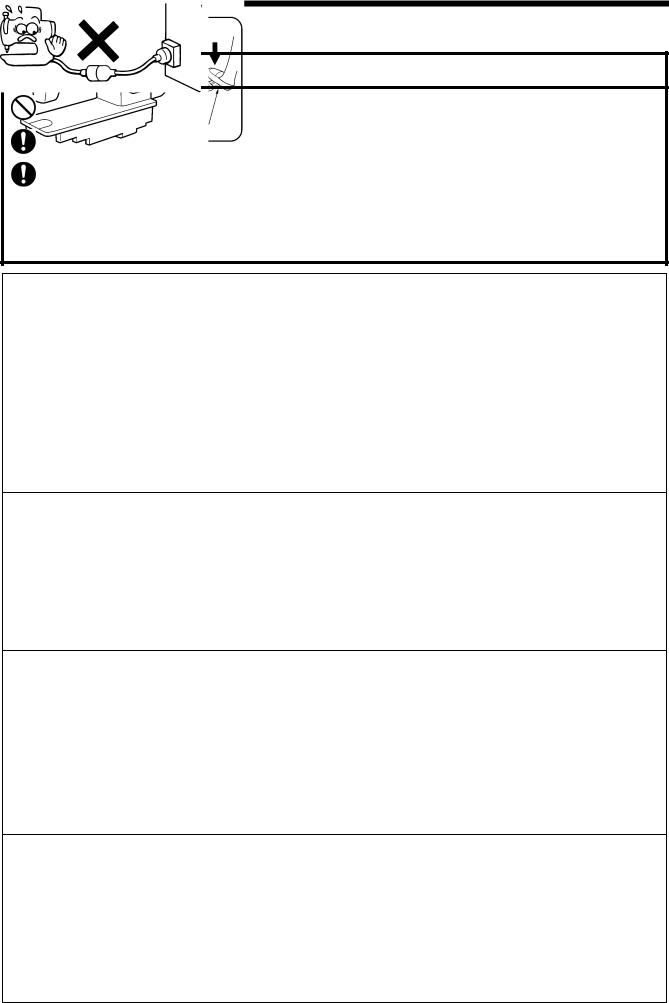
3. INSTALLATION
3. INSTALLATION
 CAUTION
CAUTION
Machine installation should only be carried out by a |
Secure the table so that it will not move when tilting |
|
qualified technician. |
back the machine head. If the table moves, it may |
|
Contact your Brother dealer or a qualified electrician |
crush your feet or cause other injuries. |
|
|
||
for any electrical work that may need to be done. |
Use both hands to hold the machine head when |
|
The sewing machine weighs approximately 38 kg |
tilting it back or returning it to its original position. If |
|
only one hand is used, the weight of the machine |
||
(84lb). The installation should be carried out by two |
||
head may cause your hand to slip, and your hand |
||
or more people. |
||
may get caught. |
||
Do not connect the power cord until installation is |
||
|
||
complete. The machine may operate if the treadle is |
|
|
depressed by mistake, which could result in injury. |
|
About the machine set-up location
Do not set up this sewing machine near other equipment such as televisions, radios or cordless telephones, otherwise such equipment may be affected by electronic interference from the sewing machine.
The sewing machine should be plugged directly into an AC wall outlet. Operation problems may result if extension cords are used.
2086M
Carrying the machine
The sewing machine should be carried by the arm and the machine pulley by two people as shown in the illustration.
*Do not hold by any part other than the machine pulley. If this is not observed, it may result in damage to the sewing machine.
1955B
Tilting back the machine head
Hold section (A) with your foot so that the table does not move, and then push the arm with both hands to tilt back the machine head.
2101B
Returning the machine head to the upright position
1.Clear away any tools, etc. which may be near the table holes.
2.While holding the face plate with your left hand, gently return the machine head to the upright position with your right hand.
2089M
3 |
S-6200A |
|

3. INSTALLATION
3-1. Table processing diagram
The top of the table should be 40 mm in thickness and should be strong enough to hold the weight and with-stand the vibration of the sewing machine.
Drill holes as indicated in the illustration below.
Control box mounting hole
Cotton stand hole
Cord hole
*
* NOTE:
Check that processing has been carried out accurately to these dimensions (4 places). If the dimensions are too deep, the safety switch may become damaged when setting up the machine head.
1956B
3-2. Installation
1. Control box
(1) Control box
(2) Bolts [3 pcs]
(3) Nuts [3 pcs]
(4) Spring washers [3 pcs]
(5) Washers [3 pcs]
2. Connecting rod
(6) Connecting rod
(7) Nut
1957B
S-6200A |
4 |
|
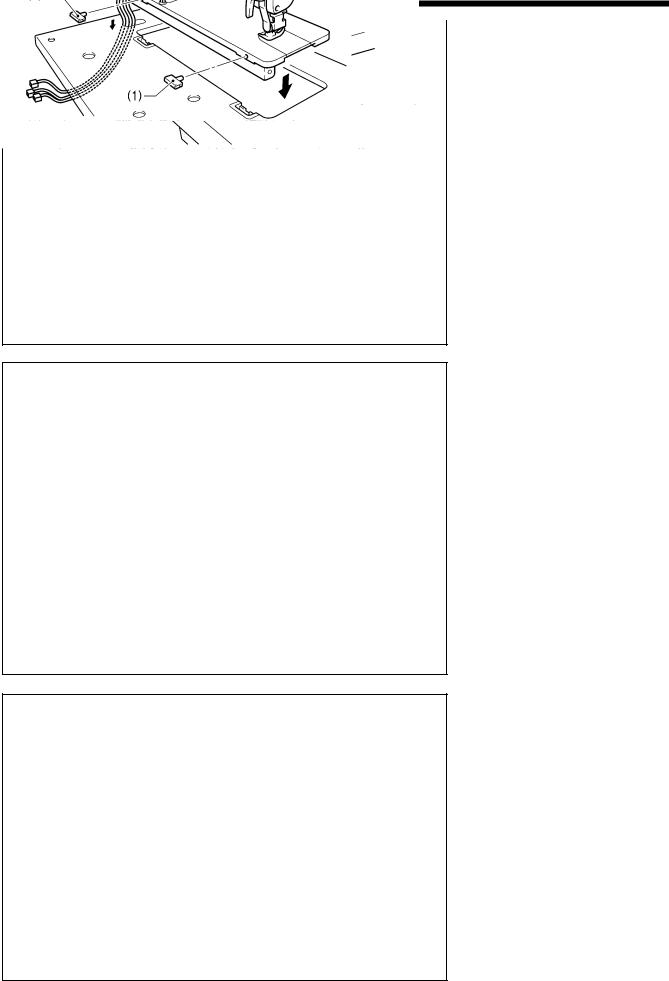
3. INSTALLATION
|
|
|
|
3. Oil pan |
|
|
|
|
|
||
|
Left side: White |
Right side: Black |
|
(1) |
Head cushions (left) [2 pcs] |
|
|
(2) |
Head cushions (right) [2 pcs] |
||
|
|
|
|
||
|
|
|
|
(3) |
Oil pan |
|
|
|
|
(4) |
Magnet |
|
|
|
|
|
|
|
|
|
|
|
|
Operator 4065M
4. Rubber cushions
(1) Rubber cushions [2 pcs]
(2) Nails [4 pcs]
]
5. Knee lifter complying bar
(3) Knee lifter complying bar
3830M
6. Machine head
(1) Hinges [2 pcs]
(2) Machine head
* Bind the cords together and pass them through the cord hole.
1958B
5 |
S-6200A |
|
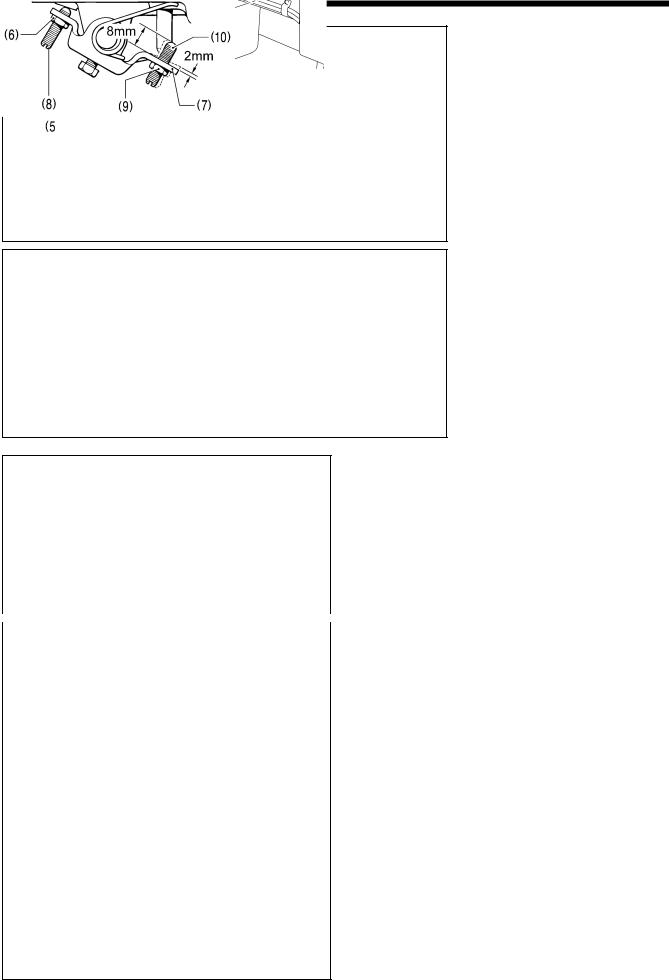
3. INSTALLATION
7. Operation panel
(1) Operation panel
(2) Screws [2 pcs]
1959B
8. Knee lifter plate
(1) Knee lifter plate
(2) Bolt
* Loosen the bolt (2) and then adjust the position of the knee lifter plate (1) so that it is easy to use.
3832M
<Knee lifter adjustment>
1.Turn the machine pulley so that the feed dog is below the top of the needle plate.
2.Lower the presser foot (5) by using the lifting lever (4).
|
|
3877M |
|
|
|
|
|
|
|
|
|
|
|
|
|
|
3834M 3. |
Loosen the nut (6). |
|
4. |
Turn the screw (8) to adjust so that the amount of play in |
|||
|
|
|
|
the knee lifter (7) is approximately 2 mm when the knee |
|
|
|
|
|
|
|
|
|
lifter plate (1) is gently pressed. |
|
|
5. |
Securely tighten the nut (6). |
|
|
|
6. |
Loosen the nut (9). |
|
|
|
7. |
Turn the screw (10) until the distance between the end of |
|
|
|
|
|
the screw (10) and the knee lifter (7) is approximately 8 |
|
|
|
|
mm. |
|
|
8. |
Turn the adjusting screw (10) to adjust so that the presser |
|
|
|
|
|
foot (5) is at the desired position within a distance of 13 |
|
|
|
|
mm of the needle plate when the knee liter plate (1) is |
|
|
|
|
|
|
|
|
|
fully pressed. |
9. |
After adjustment is completed, securely tighten the nut |
|||
|
|
|
|
(9). |
Within 13 mm
3878M
S-6200A |
6 |
|
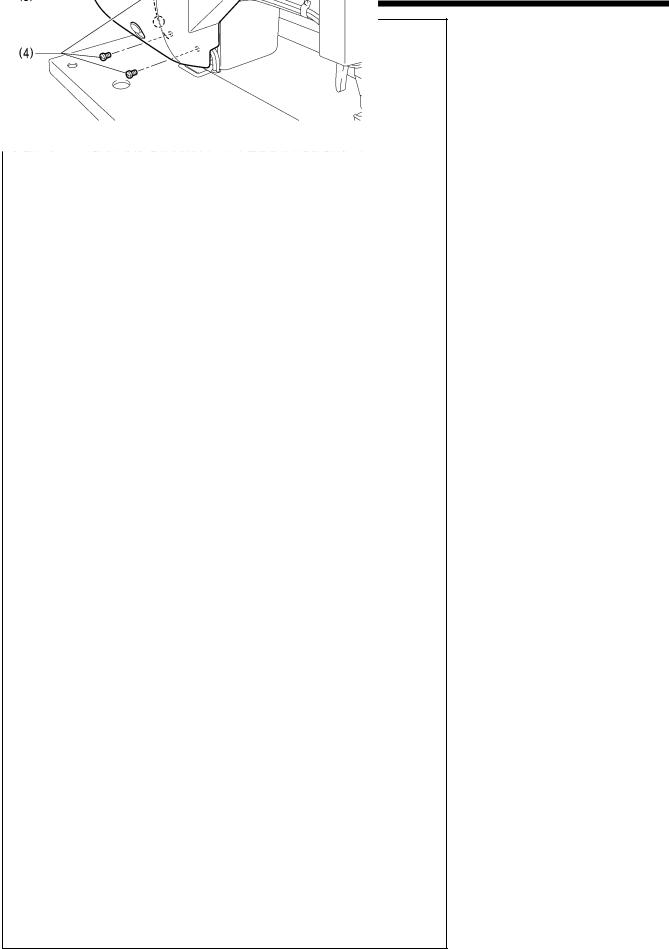
3. INSTALLATION
9. Motor cover
1. Use the two bands (2) to bind the cord (1) of the operation panel to the other cords as shown in the illustration, and then pass it through the cord hole in the table.
2. Install the motor cover (3) as shown in Figure [A], and then securely tighten it with the four screws (4).
* Fit the end of the pulley cover (5) into the grooves in the motor cover (3) (in 3 places) as shown in Figure [B].
1961B
7 |
S-6200A |

3. INSTALLATION
10. Cotton stand
(1) Cotton stand
NOTE:
Securely tighten the nut (4) so that the two rubber cushions (2) and the washer
(3) are securely clamped and so that the cotton stand (1) does not move.
3844M
3-3. Lubrication
 CAUTION
CAUTION
Do not connect the power cord until lubrication has been completed, otherwise the machine may operate if the treadle is depressed by mistake, which could result in injury.
Be sure to wear protective goggles and gloves when handling the lubricating oil, so that it does not get into your eyes or onto your skin.
If care is not taken, inflammation can result. Furthermore, do not drink the lubricating oil. Diarrhea or vomiting may result.
Keep the oil out of the reach of children.
|
The sewing machine should always be lubricated and the |
|
|
||
|
oil supply replenished before it is used for the first time, |
|
|
and also after long periods of non-use. |
|
|
Use only the lubricating oil (Nippon Oil Corporation |
|
|
Sewing Lube 10N; VG10) specified by Brother. |
|
|
* If this type of lubricating oil is difficult to obtain, the |
|
|
recommended oil to use is <Exxon Mobil Essotex SM10; |
|
|
VG10>. |
|
|
1. Tilt back the machine head. |
|
|
2. Slowly pour in lubricating oil until the oil level reaches the |
|
|
HIGH mark. |
|
3846M |
* If the oil level drops below the LOW mark, add more |
|
lubricating oil. |
||
|
S-6200A |
8 |
|

3. INSTALLATION
3-4. Connecting the cords
 DANGER
DANGER
Wait at least 5 minutes after turning off the power switch and disconnecting the power cord from the wall outlet before opening the cover of the control box. Touching areas where high voltages are present can result in severe injury.
 CAUTION
CAUTION
Contact your Brother dealer or a qualified electrician for any electrical work that may need to be done.
Do not connect the power cord until all cords have been connected.
The machine may operate if the treadle is depressed by mistake, which could result in injury.
When securing the cords, do not bend the cords excessively or fasten them too hard with staples, otherwise there is the danger that fire or electric shocks could occur.
Be sure to connect the ground. If the ground connection is not secure, you run a high risk of receiving a serious electric shock, and problems with correct operation may also occur.
3-4-1. Opening the control box cover
(1) Screw
(2) Cover
4137M
9 |
S-6200A |
|

3. INSTALLATION
3-4-2. Connecting the cords
Lower the tab (6). |
Raise the tab (6). |
Push in securely until the tabs (6) engage.
<Removal>
Press the tab.
<Securing>
Cords
<Closing the cover>
(1)6-pin head detector unit connector
(2)12-pin operation panel connector
(3)10-pin resolver connector
(4)14-pin machine connector
(5)4-pin motor connector
4139M
4140M 1. Binding the cords
(1) Repeat cable tie
NOTE:
Bind the cords in such a way that the connector does not get pulled out.
All cords that come out from the control box should be secured to the cord holder (2) using the repeat cable tie (1), otherwise vibration from the sewing machine may cause the cords to become disconnected, which can cause problems with the operation of the control box.
4141M
S-6200A |
10 |
|
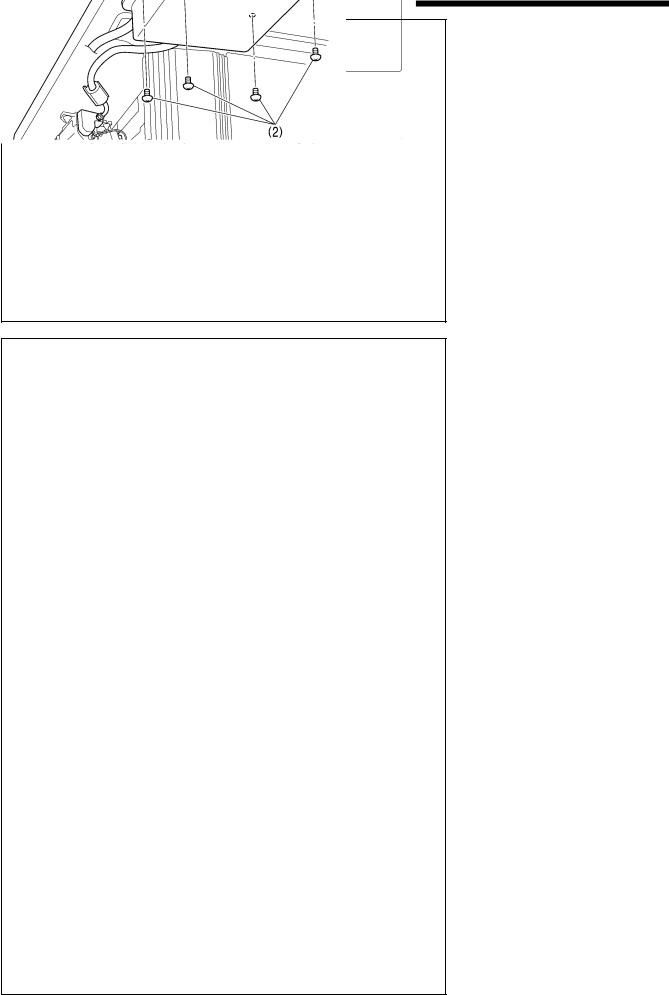
3. INSTALLATION
Ground symbol
Ground symbol |
Oil pan |
1963B
4143M
<Seen from underneath table>
Leg
Control box
Green and yellow wire (ground wire)
2129B
2. Ground wire
(1)Ground wire
(2)Washer
(3)Spring washer
(4)Screw
3. Other cords
Connect cords that match the voltage specifications.
< Europe specifications >
(1)Filter box
(2)Screws [4 pcs]
(3)Staples [7 pcs]
(4)Power cord
1.Attach an appropriate plug to the power cord (4). (The green and yellow wire is the ground wire.)
2.Insert the power plug into a properly-grounded electrical outlet.
NOTE:
Take care when tapping in the staples (3) to make sure that they do not pierce the cords.
Do not use extension cords, otherwise machine operation problems may result.
11 |
S-6200A |
|
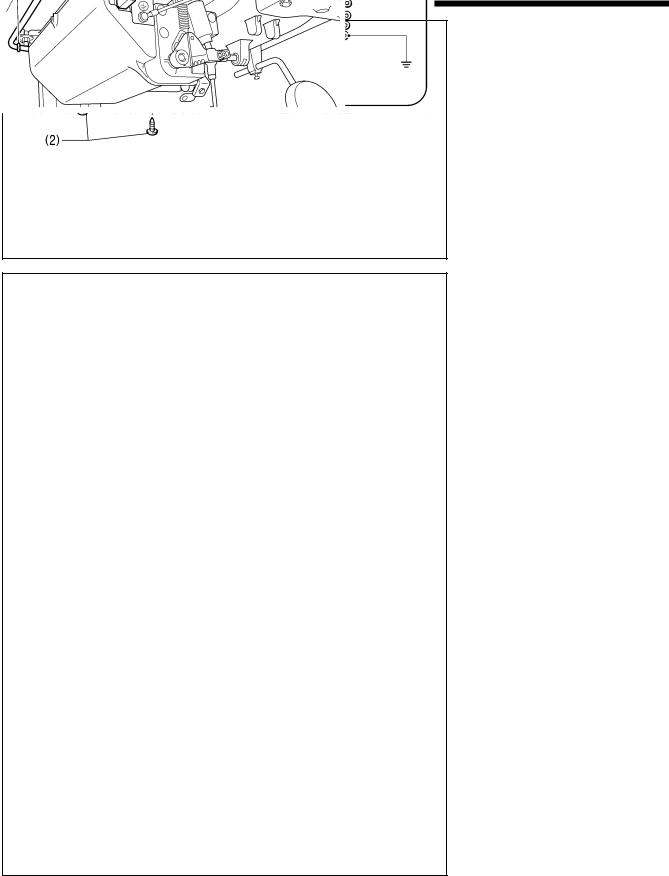
3. INSTALLATION
<200 V system >
(1) Power switch
(2) Screws [2 pcs]
Operator
4145M
1964B
Green and yellow wire (ground wire)
1965B
(3)3-pin power supply connector
(4)Power cord
(5)Staples [5 pcs]
1.Attach an appropriate plug to the power cord (4). (The green and yellow wire is the ground wire.)
2.Insert the power plug into a properly-grounded electrical outlet.
NOTE:
Take care when tapping in the staples (5) to make sure that they do not pierce the cords.
Do not use extension cords, otherwise machine operation problems may result.
S-6200A |
12 |
|
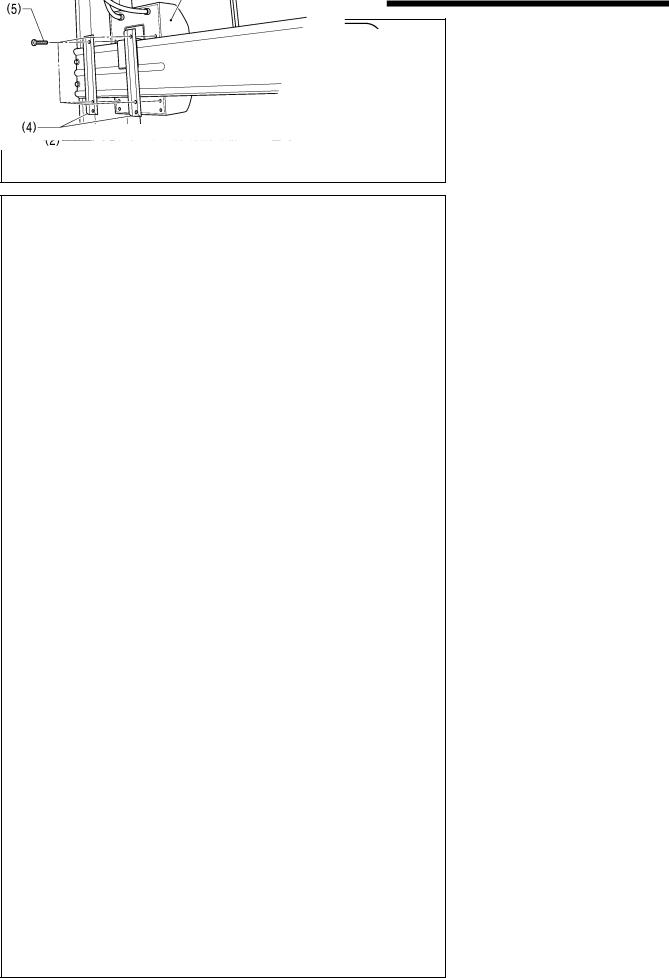
3. INSTALLATION
Operator
<100 V/400 V system >
(1)Power switch
(2)Screws [2 pcs]
4145M |
|
|
|
|
|
|
1966B |
(3) |
Transformer box |
|
|
||
|
|
|
||||
|
(4) |
Transformer box plates [2 pcs] |
|
|||
|
(5) |
Screw [with washer] |
|
|
||
|
(6) |
3-pin power supply connector |
|
|||
|
(7) |
Staples [6 pcs] |
|
|
||
|
(8) |
Cord clamps [2 pcs] |
|
|
||
|
(9) |
Power cord |
|
|
||
|
1. Attach |
an |
appropriate plug |
to |
the |
|
|
|
power cord (9). (The green and |
||||
|
|
yellow wire is the ground wire.) |
|
|||
|
2. Insert |
the |
power plug |
into |
a |
|
|
|
properly-grounded electrical outlet. |
||||
NOTE:
Take care when tapping in the staples (7) to make sure that they do not pierce the cords.
Do not use extension cords, otherwise machine operation problems may result.
Green and yellow wire (ground wire)
1967B
13 |
S-6200A |
|
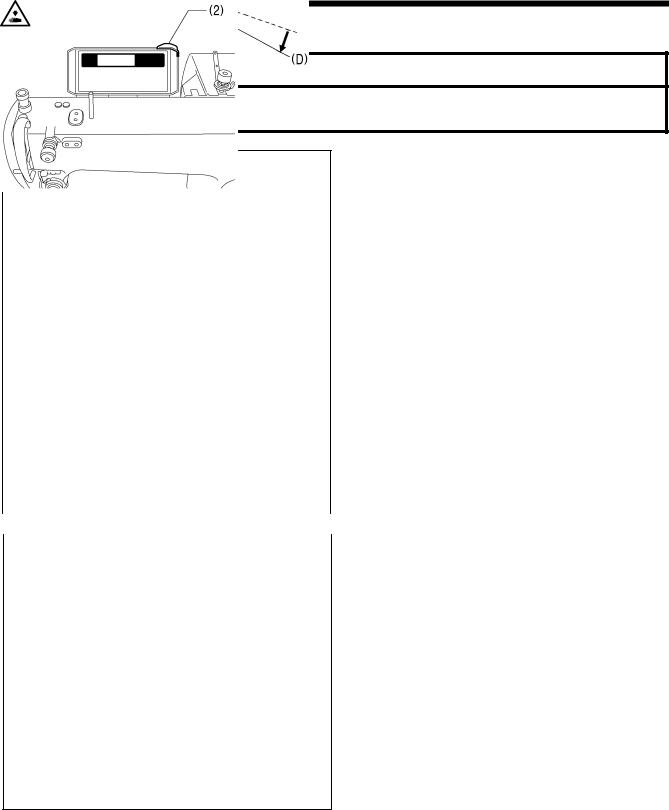
3. INSTALLATION
3-5. Test operation (Operating the treadle)
 CAUTION
CAUTION
Do not touch any of the moving parts or press any objects against the machine while sewing, as this may result in personal injury or damage to the machine.
2114M 1. Turning on the power
Press the ON power switch (1).
The power indicator (2) will illuminate.
|
|
|
|
|
1968B |
||
|
|
|
2. Test operation |
|
|
|
|
3648M |
|
|
|
1. Check that the machine sews at low speed when the treadle (1) is gently pressed to position (B).
NOTE:
If the sewing machine does not operate even when the treadle (1) is depressed, check the position of the safety switch. (Refer to “13-1. Adjusting the safety switch position”.)
2. Then check that it sews at high speed when the treadle
(1) is gently pressed to position (C).
3. After pressing the treadle (1) forward, check that the needle is lowered to the top of the needle plate when the treadle (1) is returned to the neutral position (A). (when needle down stopping has been set.)
4. If the treadle (1) is pressed to position (D), thread trimming is carried out and the needle then rises above the needle plate and stops.
2117M 5. With the machine head tilted back, depress the treadle (1) and check that the sewing machine does not operate.
NOTE:
If the sewing machine operates when the treadle (1) is depressed while the machine head is tilted back, the safety switch is probably faulty. Contact the place of purchase.
S-6200A |
14 |
|
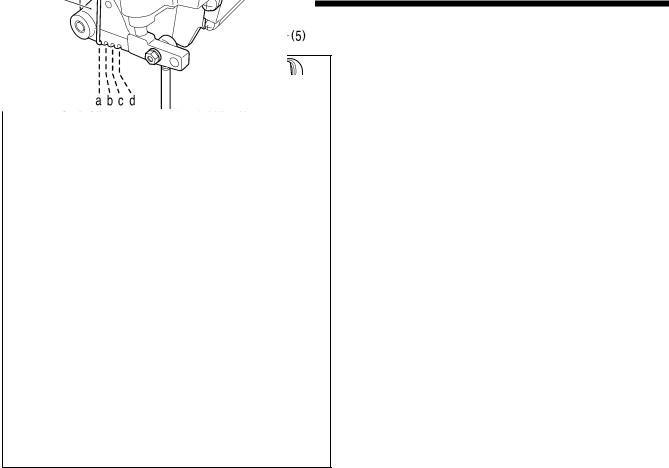
3. INSTALLATION
3-6. Adjusting the treadle operation
4259M
4260M
<Forward depression sensitivity adjustment>
If the machine starts running at low speed when your foot is simply resting on the treadle, or if the treadle pressure is felt to be too weak, adjust the position (a to c) at which the treadle spring (1) is hooked onto the treadle lever (2).
*a is the weakest position, and it becomes gradually stronger at b, c and d respectively.
<Backward depression sensitivity adjustment>
1.Loosen the nut (3) and turn the bolt (4).
*When the bolt (4) is tightened, the treadle operation becomes heavier, and when it is loosened, the operation becomes lighter.
2.Tighten the nut (3).
<Adjusting the treadle stroke>
Remove the nut (5), and then move the connecting rod joint
(6) from the position in figure A to the position in figure B. The treadle stroke will then be increased by approximately 27 %.
At this time, the treadle forward and backward depression sensitivity will change, so readjust if necessary.
15 |
S-6200A |
